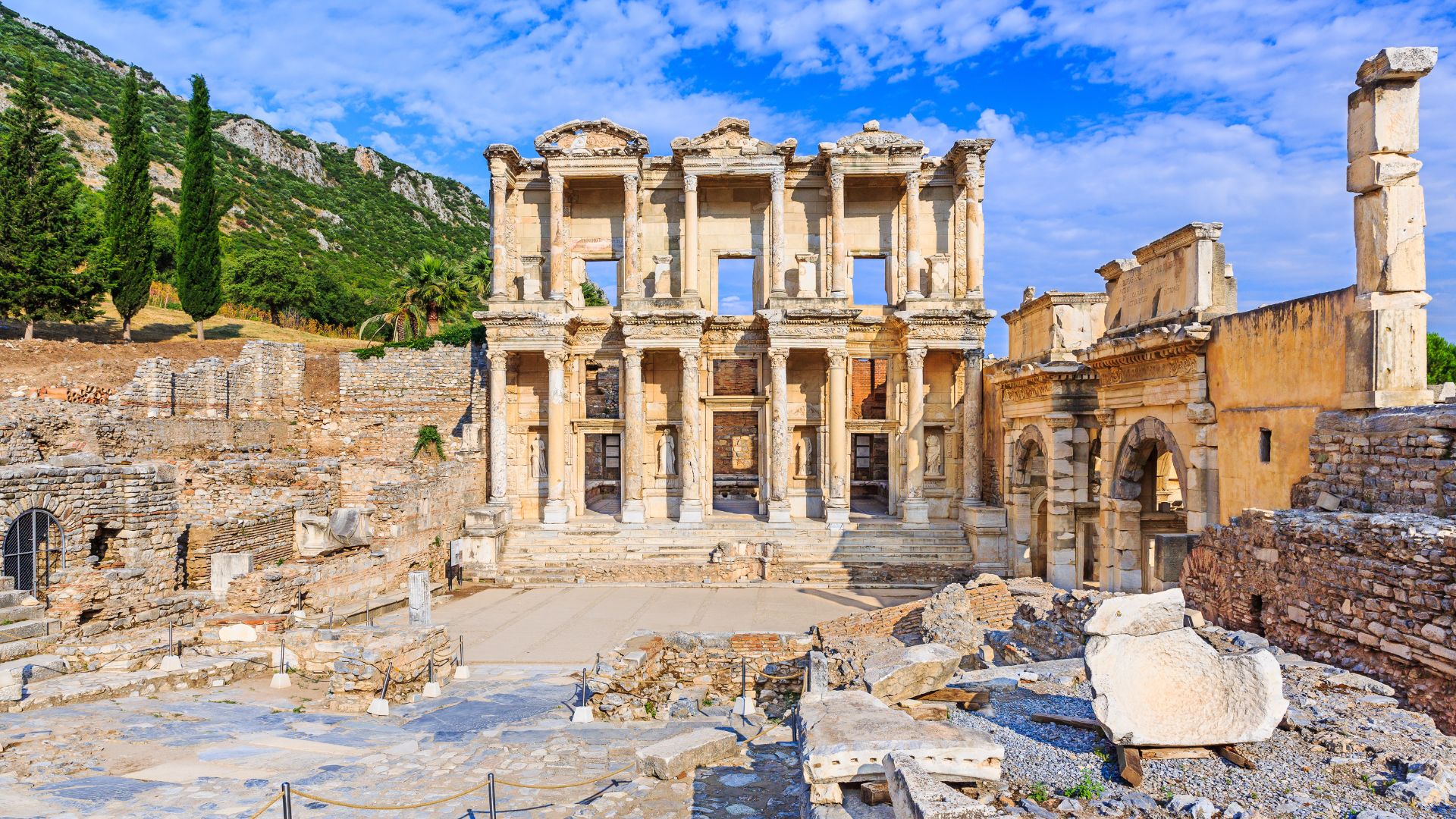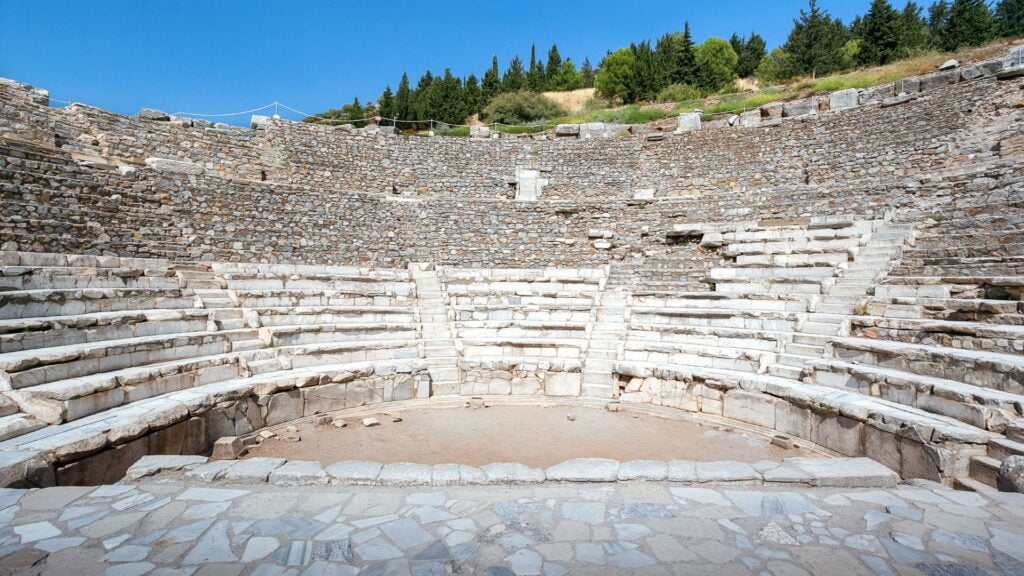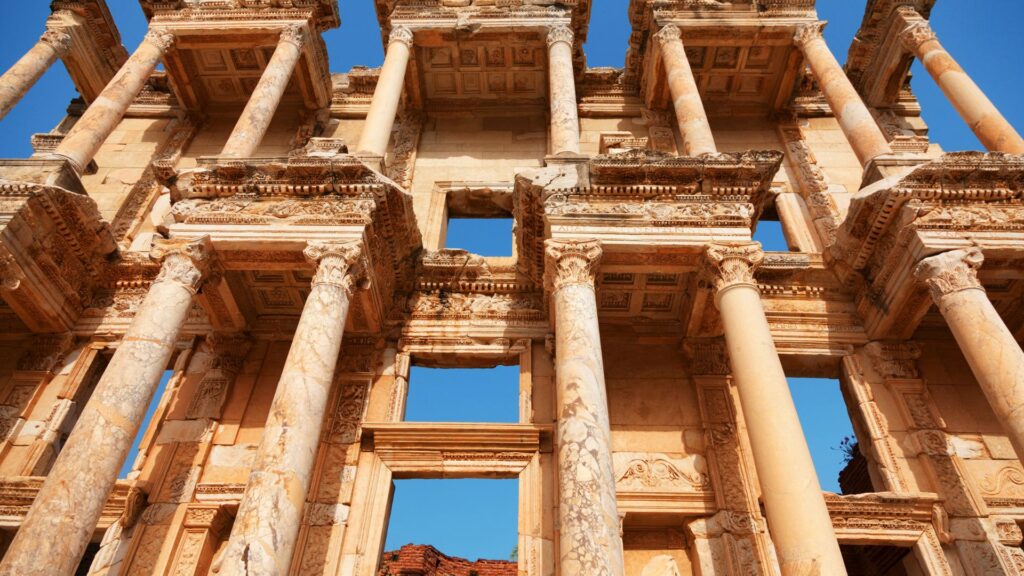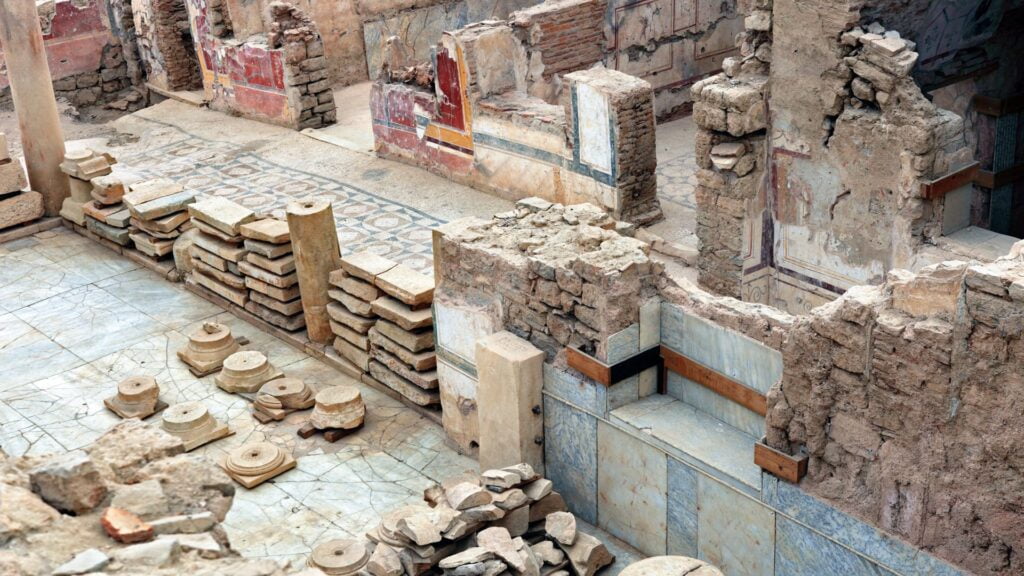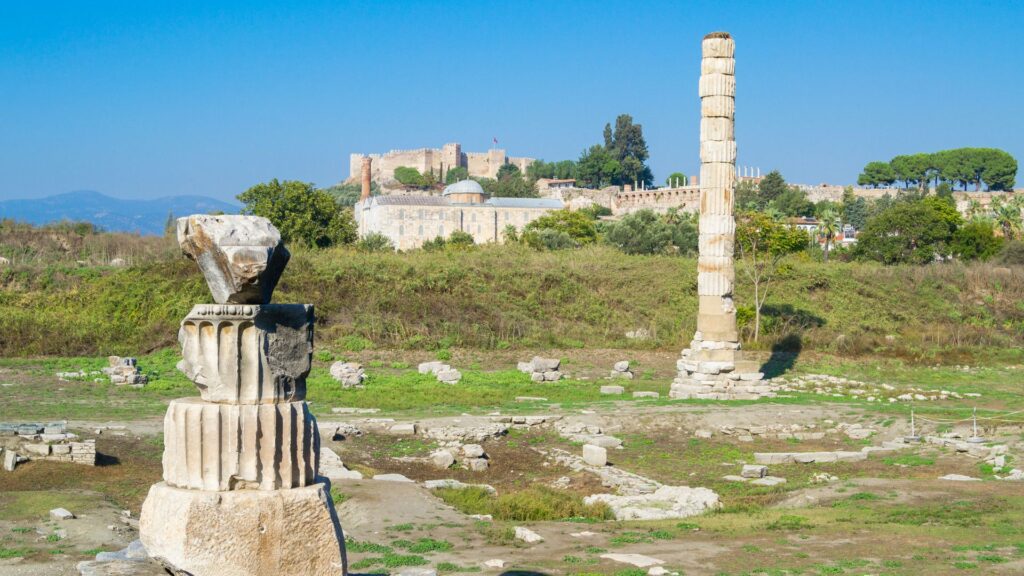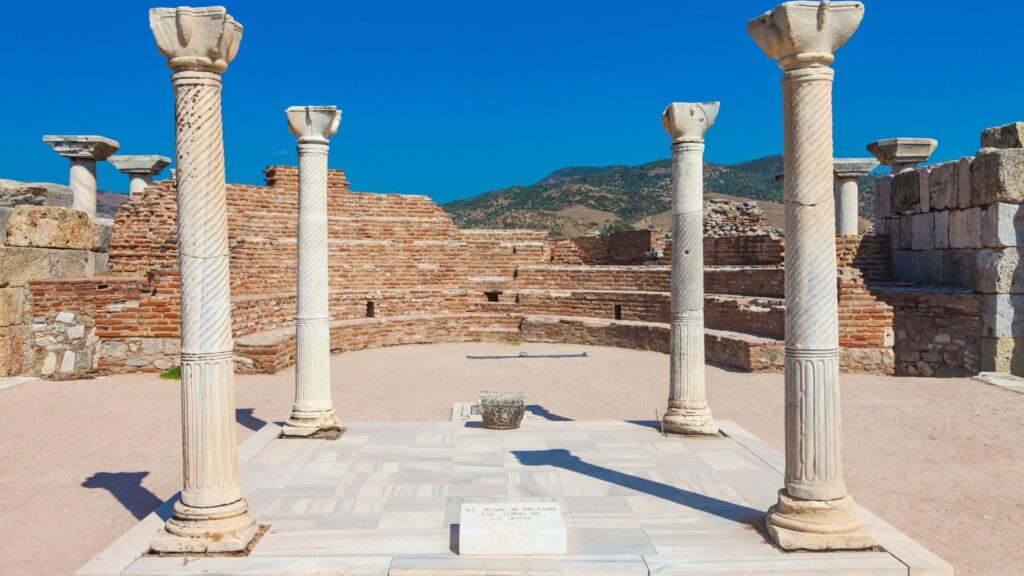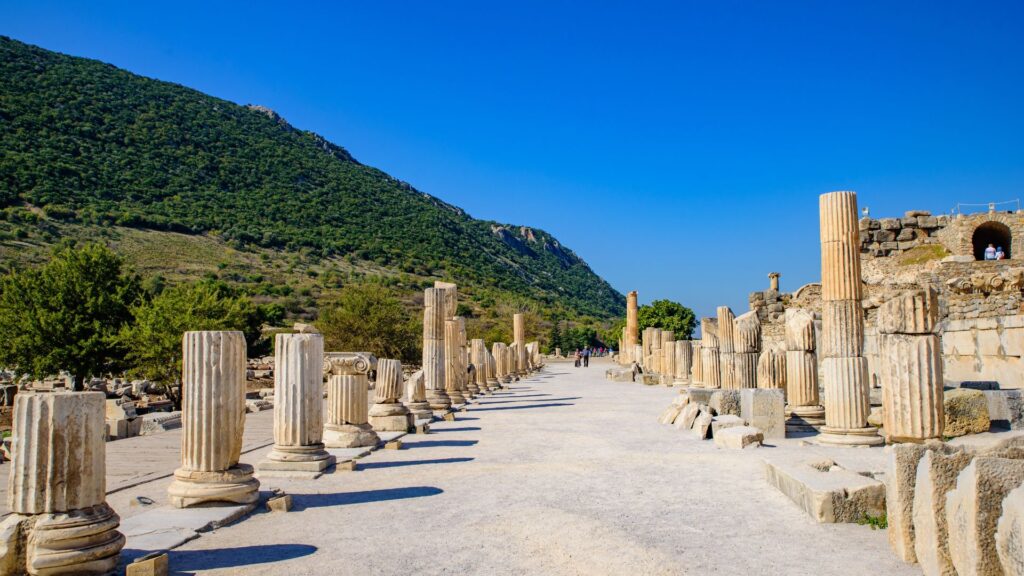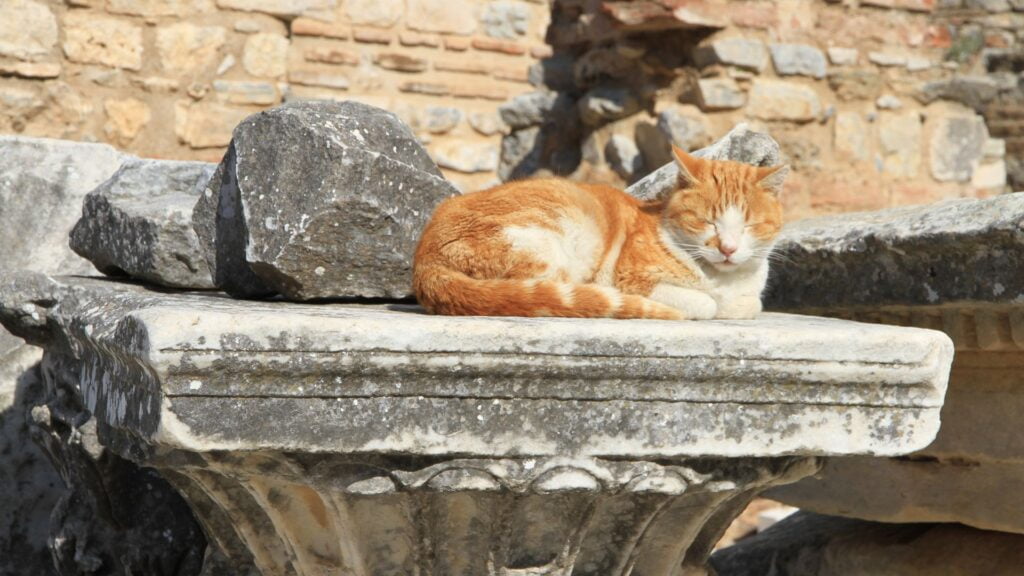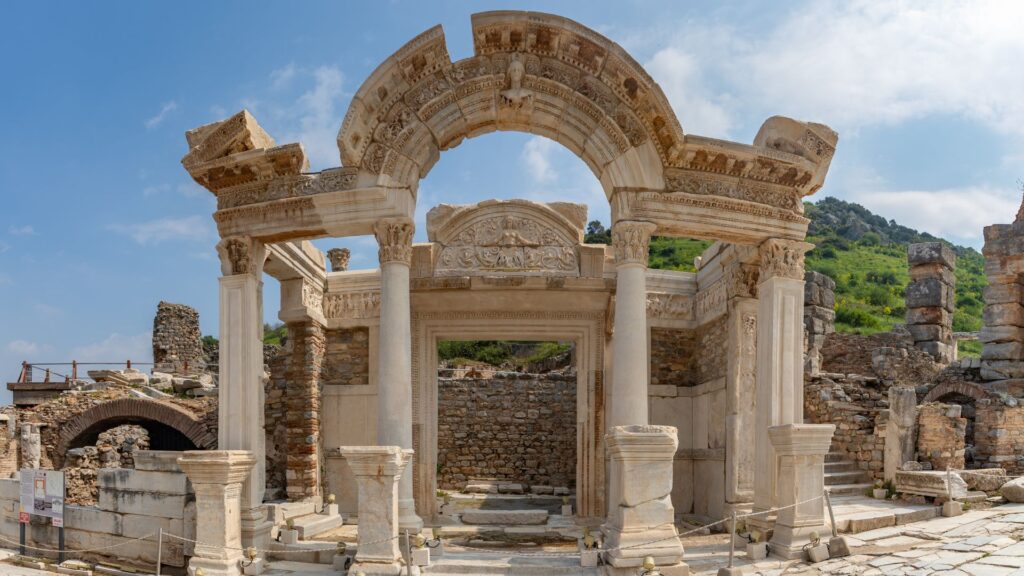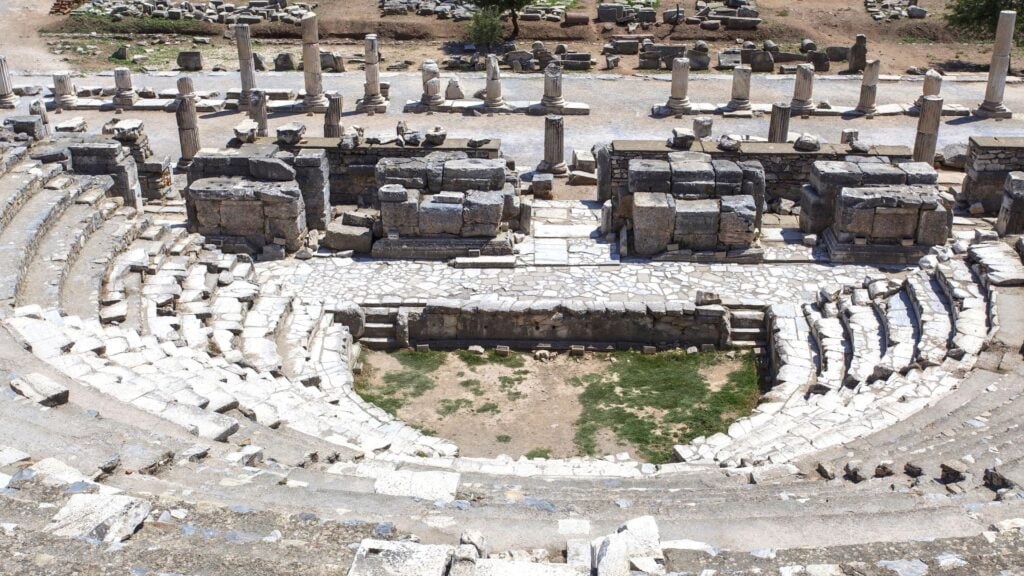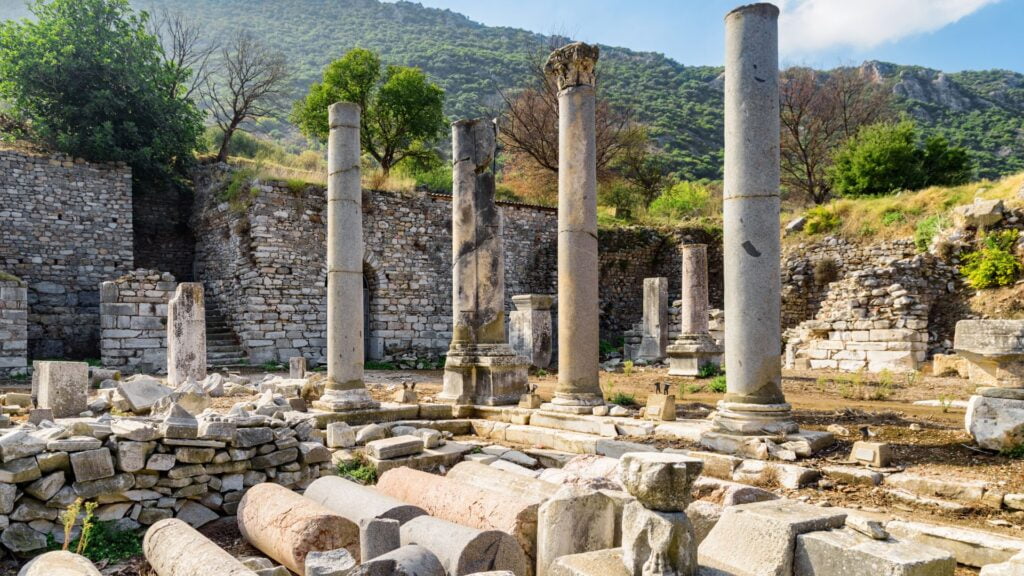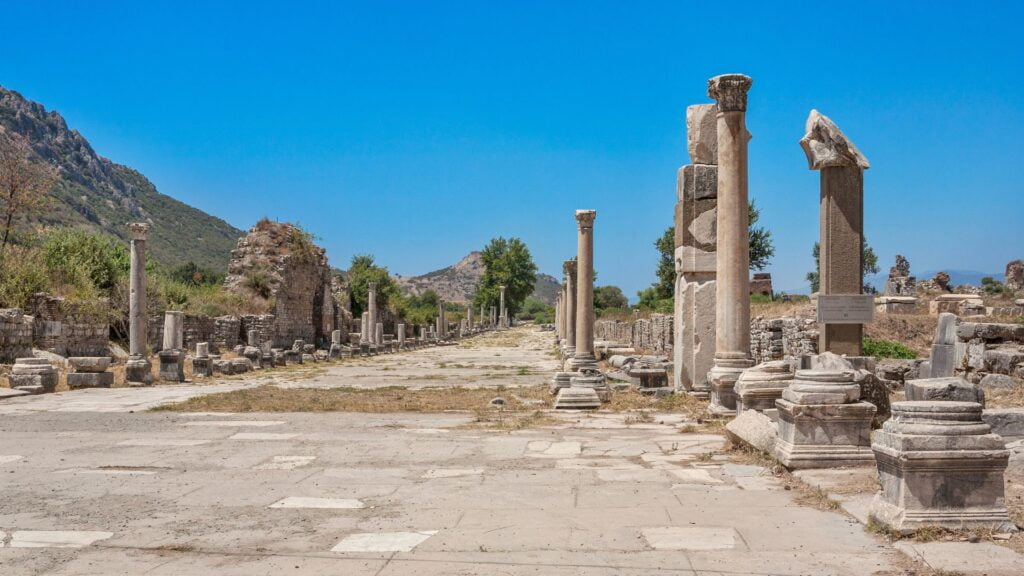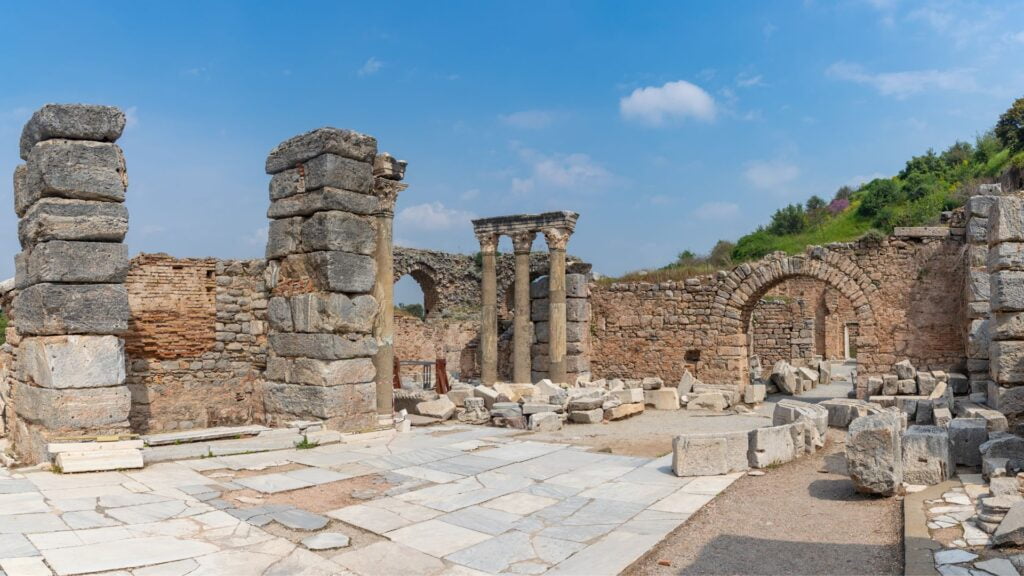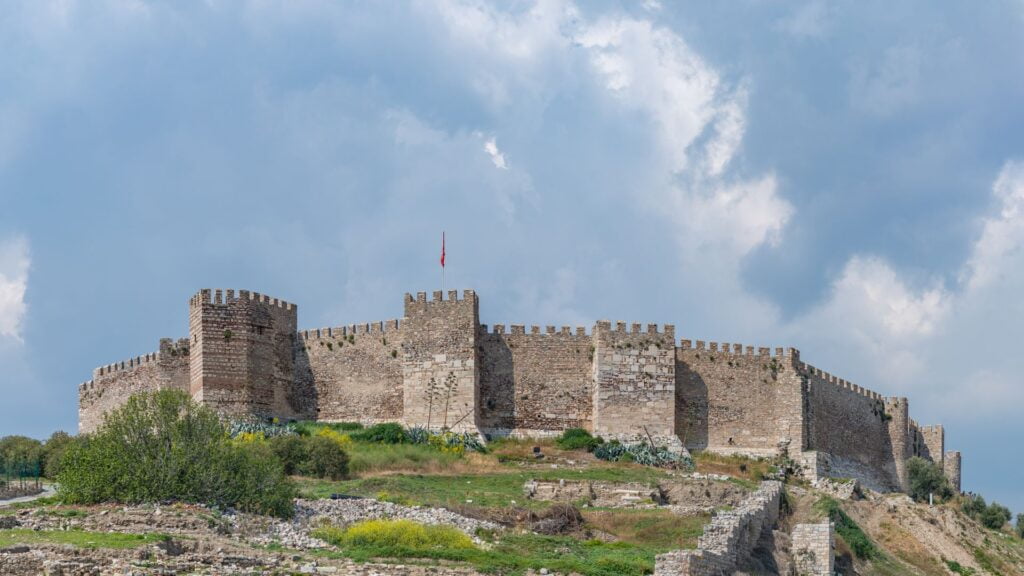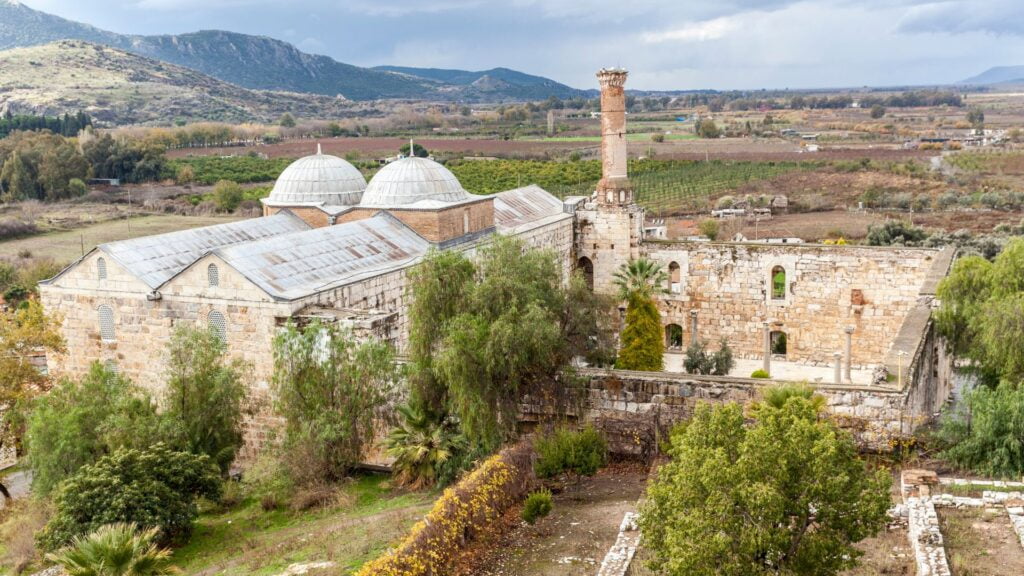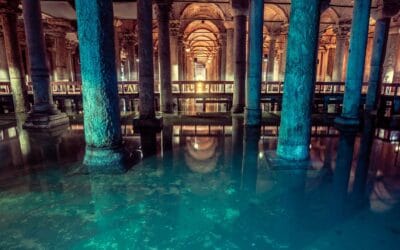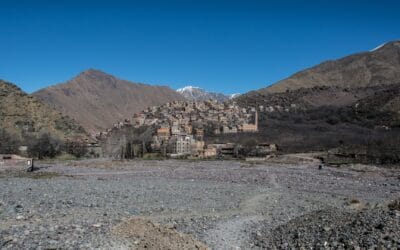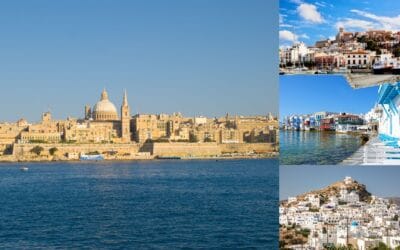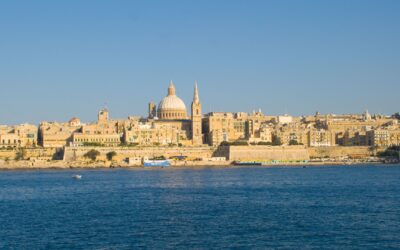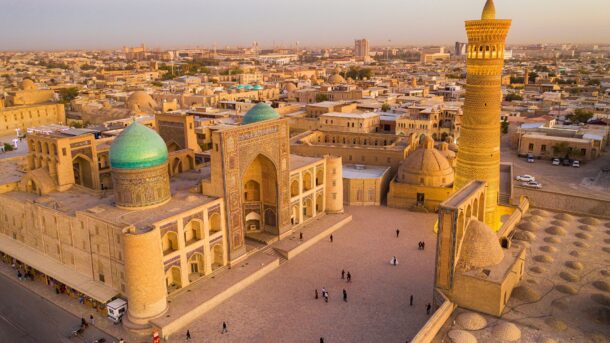Into ancient cities? How about Greek and/or Roman history? Are you planning a trip to Turkey or on the so-called Silk Road? If the answer is yes to any of these questions, it may be the time to find out a few things about Ephesus – a UNESCO World Heritage Site since 2015 that continues to be a valuable resource for understanding ancient Greek and Roman history. Why, you may wonder? Let’s find out by taking a look at some things I would do and see in Ephesus.
The unwritten and written history of Ephesus
We don’t know for sure how Ephesus was born. According to one legend, the city was founded by the Amazons and named after their queen. Another legend says that the city was established by Androklos, a prince of Athens, guided by a fish and a wild boar. This legend seems to have been taken quite seriously, as these two symbols are still depicted in Ephesus today. Last but not least, archaeological evidence places the earliest human settlements in the region as far back as the Neolithic age, around 6000 BCE.
You may find it interesting to know that one of the oldest contents resembling modern advertisements ever discovered is carved into the pavement of Ephesus. This ancient “ad”, which dates back to around 2,000 years ago, directed visitors to a nearby brothel, showing a woman’s head, a heart, and a left foot
By the Bronze Age, the area was part of the Arzawan kingdom, with its capital at Apasa, which later became known as Ephesus. The city’s strategic location along the Aegean coast made it an attractive site for Greek colonization around 1000 BCE, leading to its development as one of the twelve cities of the Ionian League, a confederation of Greek city-states in Asia Minor. Speaking of Greek, Ephesus is the birthplace of the famous philosopher Heraclitus.
During the 7th century BCE, Ephesus faced invasions by the Cimmerians but, unlike many of its neighbors, survived. The city fell under the rule of the Lydian king Croesus in the 6th century BCE, who contributed to the reconstruction of the Temple of Artemis, one of the Seven Wonders of the Ancient World. The city then came under Persian control after Croesus’s defeat by Cyrus the Great. Despite a failed rebellion against Persian rule during the Ionian Revolt, Ephesus maintained a relatively peaceful relationship with the Persians until the arrival of Alexander the Great in 334 BCE, who brought the city under Hellenistic rule.
Ephesus eventually became part of the Roman Empire and, in 128 BCE, became the capital of the Roman province of Asia. Important structures emerged during this period, including the Library of Celsus, the Great Theatre, and the Temple of Hadrian.
Eventually, the city started to decline, sometime aroundthe 3rd century CE, when it was sacked by the Goths. Although partially rebuilt, the city’s importance dwindled as its harbor, key for trade, gradually silted up, making it less accessible. The rise of the Byzantine Empire saw Ephesus continue as a regional center, albeit less prominent than before. The city’s decline accelerated due to repeated earthquakes, including a major one in 614 CE, and the ongoing silting of its harbor.
Ephesus was also an important node on the East-West networks belonging to the Silk Road, being an endpoint for goods traveling from Asia, such as spices, silks, and precious stones.
Interest in Ephesus was rekindled in the 19th century, leading to extensive archaeological excavations that continue to this day. These excavations have uncovered significant portions of the ancient city, including the Library of Celsus, the Great Theatre, and several other public and private buildings.
Things to do & see while exploring Ephesus
Time for some exploration tips. You will most likely first arrive in Selçuk, a town in İzmir Province with a population of approximately 37,700. The town can serve as a hub for exploring the entire area, including Ephesus.
If I were you, planning a trip to Ephesus, I would first take a close look at all the main attractions and prioritize so that I would be sure there’s little chance of missing one of the attractions in question due to lack of time or other reasons.
With this in mind, let’s take a good look at the things I would visit on my first trip to the ancient city, in no particular order. The purpose of this review is to help you get a sense of what you may like the most.
The Great Theatre of Ephesus
Perhaps the most famous landmark in the ancient city, the Great Theatre of Ephesus is also one of the most well-preserved ancient structures in the area. Located on the western slopes of Panayır Hill, it is easily visible when entering Ephesus from the south entrance. Let’s say the theatre is to Ephesus what Hagia Sophia is to Istanbul.
The Great Theatre of Ephesus looks great
The initial construction of the theatre began during the Hellenistic period in the 3rd century BCE, under the reign of Lysimachus, a general of Alexander the Great. The structure was significantly expanded during the Roman period, particularly under Emperors Claudius, Nero, and Trajan, between 41 and 117 CE.
The theatre was primarily built using marble and could accommodate up to 24,000 spectators, making it one of the largest theatres of the ancient world. It featured a three-story stage building (scaenae frons) adorned with intricate columns and statues. The theatre’s architectural design showcased acoustics and seating arrangements that ensured clear visibility and audibility from all sections.
Things you will see:
- The Cavea: The semi-circular seating area was designed to provide a good view of the stage from all seats. The steepness of the rows increases with height, improving sightlines for those seated at the back.
- The Skene: The stage building, originally two stories tall and later expanded to three, featuring elaborate decorations including columns, niches, and statues of deities and emperors.
- Orchestra: The circular area in front of the stage where the chorus would perform. This space was later used for gladiatorial contests during the Roman era.
- Marble Road: Leading to the theatre, this road belongs to the city’s ancient infrastructure.
- Altars and Statues: Various altars were used for sacrifices to Dionysus and other deities. OK…
The Great Theatre is part of the larger Ephesus archaeological site, which is open to visitors year-round. The site is typically open from 8:00 AM to 7:00 PM in the summer months and from 8:00 AM to 5:00 PM in the winter months.
Ticket prices:
- Adults: $15 USD (€14)
- Children (under 12): Free
- Students: $10 USD (€9)
While I would not want to be a spectator at the types of shows I imagine took place during the theatre’s “golden” years, the Great Theatre of Ephesus would probably be my first stop.
Library of Celsus
The Library of Celsus was constructed in 117 CE by Gaius Julius Aquila to honor his father, Tiberius Julius Celsus Polemaeanus, who was a Roman senator and proconsul of Asia. Situated near the agora, the library served both as a repository of knowledge and a monumental tomb for Celsus, whose sarcophagus was placed beneath the ground floor. Today, it is a place where you can go to get an idea of what an ancient learning center looked like.
The Library of Celsus looks quite amazing
The library is a blend of Roman and Greek styles. The facade features two levels of columns with Corinthian capitals. The central doorway is flanked by four statues representing Wisdom (Sophia), Knowledge (Episteme), Intelligence (Ennoia), and Valor (Arete). Inside, the library’s dimensions were 16.72 m by 10.92 m (54.8 by 35.8 ft), and it housed around 12,000 scrolls.
Things you will see:
- Facade: The decorated facade with its double-story columns and statues.
- Sarcophagus: The burial chamber of Celsus, originally housed in an intricately carved sarcophagus.
- Interior Niches: Although the interior structure is mostly lost, the niches where scrolls were stored are still visible.
- Replica Statues: The statues in the niches on the facade are modern replicas of the originals, which are now housed in museums.
The Library of Celsus is also part of the Ephesus archaeological site. As such, I would take a look at it either before or after going to the Great Theatre.
Terrace Houses
The Terrace Houses, also known as the “Houses of the Rich,” are a complex of luxurious residential villas located on the slopes of Bülbüldağı Hill. These are the houses where Ephesus’s wealthy individuals lived during the Roman period. Constructed according to the Hippodamian plan, the houses are built on terraces (hence the name) and feature quite advanced architectural techniques and some interesting decorations.
Terrace Houses
The excavation of the Terrace Houses began in 1960 and has revealed significant details about the lifestyle and social structure of their inhabitants. These homes date back to the 1st century BCE and were occupied until the 7th century CE. The complex consists of several multi-story houses, each with its own courtyard (peristyle), private baths, and intricate mosaics and frescoes.
Things you will see:
- Mosaics and Frescoes: The floors and walls of the houses are adorned with mosaics and frescoes, depicting mythological scenes, geometric patterns, and figures such as Dionysus, Medusa, and Socrates.
- Courtyards and Fountains: Many houses feature central courtyards surrounded by colonnades, with some including ornate fountains and pools used to collect rainwater.
- Private Baths and Heating: The houses had plumbing systems with private baths and underfloor heating.
- Transparent Walkways: Visitors can walk on transparent floors that allow a view of the ancient structures below. If you’re afraid of heights, this might not be for you.
The Terrace Houses are part of the Ephesus archaeological site; however, an additional entrance fee is required to visit them. Personally, I would not be cheap when it comes to these structures.
Temple of Artemis
The Temple of Artemis, also known as the Artemision, is, as already mentioned, one of the Seven Wonders of the Ancient World. The temple was originally built in the 6th century BCE and dedicated to Artemis, the Greek goddess of the hunt, wilderness, and childbirth. The building was funded by the Lydian king Croesus and designed by the Cretan architects Chersiphron and his son Metagenes. It was known for its grand scale, measuring 115 m (377 ft) in length and 46 m (151 ft) in width, with over 100 marble columns each standing 18 m (59 ft) high.
Temple of Artemis
This temple has quite a tumultuous history. It was first destroyed in 356 BCE by an arsonist named Herostratus, who supposedly sought fame through its destruction. It was subsequently rebuilt, only to be destroyed again by the Goths in 262 CE. Despite these setbacks, the temple remained a significant religious site until its final destruction by a Christian mob in 401 CE, following a decree by Roman Emperor Theodosius I against the so-called pagan practices. You can tell that UNESCO wasn’t around back then.
Today, little remains of the once grand Temple of Artemis. You will see a single reconstructed column standing amidst the ruins, with the foundations of the temple and some scattered marble fragments being visible. Artifacts from the temple, including sculptures and column fragments, are displayed in several museums around the world. For example, the British Museum in London houses several things from the temple, including a column drum with an inscription by Croesus.
The site of the Temple of Artemis is also part of the larger Ephesus archaeological area. This would be my stop after I’ve seen the Great Theatre of Ephesus, the Temple of Artemis, and the Terrace Houses, especially if I don’t have enough time to visit the archaeological area at a good pace.
Basilica of St. John
The Basilica of St. John was built in the 6th century CE by Emperor Justinian I. The basilica was constructed over the believed burial site of St. John the Apostle and stands on Ayasuluk Hill, providing a strategic view of the surrounding area and the ancient city of Ephesus.
Basilica of St. John.
The building is an example of Byzantine design, modeled after the now-lost Church of the Holy Apostles in Constantinople. It features a cruciform layout with six domes and was originally adorned with intricate mosaics, frescoes, and marble columns.
Things you will see:
- St. John’s Tomb: The tomb is marked by a simple marble slab.
- Architectural Layout: The remains of the basilica’s cruciform structure, including the central nave, domes, and massive supporting pillars.
- Baptistery and Frescoes: The octagonal baptistery and fragments of the original frescoes and mosaics that once decorated the interior.
- Gate of Persecution: The main entrance to the basilica, named for its historical significance.
The Basilica of St. John is part of the Ephesus archaeological site. As such, I would take a look at it after I’ve seen the earlier-mentioned structures.
Curetes Street
Curetes Street is by far one of the main thoroughfares of ancient Ephesus. The street stretches from the Hercules Gate to the Library of Celsus and is named after the Curetes, a class of priests who were associated with the cult of Artemis and had the major responsibility of maintaining the sacred fire in the Prytaneion. Curetes served as a central artery in the city, connecting various significant areas and structures.
The fairly interesting Curetes Street
The street was originally laid out during the Hellenistic period and later repaved with marble during the Roman era. It spans approximately 210 m (688 ft) in length and varies in width from 6.8 to 10 meters (22.3 ft to 32.8 ft). While crossing Curetes Street you may notice its diagonal orientation, which cuts across the more typical grid pattern of the city.
Things you will see:
- Monuments and Statues: The street is not only interesting because of its history. Curete is lined with various monuments, including the Fountain of Trajan and the Temple of Hadrian. Statues of prominent figures once adorned the colonnaded galleries along the street.
- Hercules Gate: At one end of the street stands the Hercules Gate, which lets you know that you’re not on just any ancient street but one that was important to the city.
- Residential and Commercial Structures: The street was flanked by luxurious homes (by ancient standards, of course), many with colonnaded galleries and intricate mosaics. Ancient forms of shops and workshops were located underneath these houses, meaning the street also functioned as some sort of ancient commercial district.
- Fountains and Baths: Public fountains, such as the Pollio Fountain, provided water to residents and travelers, while public baths offered a place for relaxation and socialization.
Curetes Street is part of the Ephesus archaeological site. I think the street is the first thing you should pay attention to when entering the archeological site, and move to buildings afterwards. At least that’s what I would do.
Ephesus Museum
Now that you’ve seen so much of the archeological site, you may want to take a look at stuff that will provide you more details on how life was during the time Ephesus was a thriving city. The Ephesus Museum is located in Selçuk and houses artifacts from various periods, including Mycenaean, Archaic, Classical, Hellenistic, Roman, Byzantine, Seljuk, and Ottoman eras.
Somewhere around the Ephesus Museum and a cat
The museum was established to prevent the removal of artifacts from Turkey, following a period when many significant finds were sent abroad to museums in Vienna and London. The museum reopened in November 2014 after extensive renovations and is organized thematically rather than chronologically. The thematic spaces include:
- Hall of the Fountain Relics: Displays artifacts from the numerous fountains that once adorned Ephesus.
- Terrace Houses Findings Hall: Contains items from the homes of Ephesus’s elite, including mosaics, frescoes, and household items.
- Coins and Treasure Hall: Exhibits a collection of ancient coins, including the earliest electrum coins depicting stags, sacred to Artemis.
- Artemis Hall: Houses statues of the goddess Artemis, including the famous large statues from the Temple of Artemis.
- Emperor Cults Hall: Displays statues and busts of Roman emperors and other known figures.
The Ephesus Museum is open year-round with varying hours depending on the season. From April 15 to October 2 (summer season), it is open from 8:00 AM to 7:00 PM. From October 3 to April 14 (winter season), it is open from 8:00 AM to 5:00 PM. The museum is closed on the first day of religious holidays until 1:00 PM.
Ticket prices:
- Adults: $10 USD (€9)
- Children (under 12): Free
I don’t know about you, but I like archeological museums a lot. As such, the Ephesus Museum will be my first touristic stop in Selçuk. I would say the museum is equally entertaining regardless of whether you visit it before or after going to the archeological site. As such, the decision should be rather based on your itinerary.
Temple of Hadrian
The Temple of Hadrian is one of the most well-best-preserved structures in Ephesus. It was constructed in 138 CE and dedicated to Emperor Hadrian, who visited Ephesus in 128 CE. This small yet intricately designed temple was built by a wealthy Ephesian named P. Quintilius Vedius Antoninus Sabinus.
The somewhat well-preserved and pretty Temple of Hadrian
The temple has a tetrastyle prostyle design, featuring four Corinthian columns at the front. These columns support a decorated arch and pediment, which includes reliefs of Tyche, the goddess of fortune, and intricate floral motifs. The building also features a pronaos (front hall) and a cella (main room), which originally housed the statue of Emperor Hadrian. The decoration of the temple includes a semi-circular relief of Medusa above the entrance and friezes depicting mythological scenes, such as the foundation of Ephesus by the Athenian prince Androclus.
Things you will see:
- Corinthian Columns: These carved columns are a highlight of the temple’s facade.
- Relief Sculptures: The temple’s friezes depict various mythological scenes, including the foundation of Ephesus and other significant events. The originals of these reliefs are housed in the Ephesus Museum, with replicas displayed at the site.
- Medusa Relief: Above the entrance, this semi-circular relief shows Medusa surrounded by acanthus leaves.
The Temple of Hadrian is part of the Ephesus archaeological site. Since it’s located near the Library of Celsus, on the south side of Curetes Street, I would visit it after I’ve seen the Library of Celsus.
Odeon of Ephesus
The Odeon of Ephesus, also known as the Bouleuterion, is a small, semi-circular theater originally constructed in the 2nd century CE. This multifunctional structure was financed by the wealthy Ephesian citizens Publius Vedius Antonius and his wife Flavia Paiana. It served two main purposes: as a Bouleuterion, where the city council (Boule) met to discuss political and administrative matters, and as an Odeon, or concert hall, for musical performances and social events.
Odeon of Ephesus
The Odeon features a typical Roman theater design with a stage building, seating areas, and an orchestra. The stage building was two stories high, and it is believed the structure might have been roofed, which is unusual for such buildings, due to the lack of a drainage system.
The seating capacity of the theatre was approximately 1,500 spectators. The seating area was divided into two sections by a circular walkway called a “diazoma,” with the lower, more spacious seats reserved for important individuals. The building includes a narrow podium in front of the stage, raised about one meter above the orchestra section
Things you will see:
- Stage Building: The remains of the two-story stage building, which was originally adorned with columns.
- Seating Areas: The semi-circular seating arrangement, divided by the diazoma, offers a glimpse into the social hierarchy of ancient Ephesus.
- Podium and Orchestra: The narrow podium in front of the stage and the orchestra section where musicians and performers would have been located.
The Odeon is part of the Ephesus archaeological site. If there’s time pressure, it would be the second ancient theatre I visit, after the Great Theatre of Ephesus.
Agora of Ephesus
The Agora of Ephesus, like any ancient agora, was an integral part of the city’s civic and commercial life. The area was established in the 3rd century BCE and extensively developed during the Roman period. The Agora was divided into two main sections: the State (Upper) Agora and the Commercial (Lower) Agora.
Agora of Ephesus
The State Agoraserved primarily for administrative and governmental purposes. It was bordered by colonnaded porticoes, with the northern side featuring the Stoa Basilica, a two-story structure adorned with Ionic columns with bull’s head capitals. This section of the Agora was used for public meetings, court proceedings, and other municipal activities. A large temple, often referred to as the Temple of Isis, stood on its western side. The State Agora was also home to several fountains and a large cistern, which played a key role in the city’s water supply.
The Commercial Agora, located near the harbor, was a square-shaped marketplace surrounded by stoas with shops and workshops. This part of the agora was reconstructed several times, particularly under the reigns of Emperors Augustus and Nero, and later by Caracalla. It included a basilica, initially intended as a court, and numerous statues of deities, philosophers, and officials.
Things you will see:
- Colonnaded Porticoes: The stoas, which once housed shops and meeting spaces, lined the Agora and provided shade and shelter for traders and visitors.
- Stoa Basilica: This two-story structure served both commercial and religious purposes.
- Temple of Isis: Located in the State Agora, this temple is one of the several examples of the religious character of ancient Ephesus.
- Statues and Inscriptions: Numerous statues and inscribed bases, remnants of the decor of the Agora, provide insights into the social and political life of the city. For archeologists, at least.
- Water Features: The remains of fountains and a large cistern highlight the advanced water management systems of the city.
The Agora is part of the Ephesus archaeological site. I would explore the area once I’ve seen the other landmarks mentioned above.
Harbor Street (Arcadian Street)
Harbor Street, also known as Arcadian Street, was another significant “boulevard” in ancient Ephesus. Originally built during the Hellenistic period in the 1st century BCE, this street was later renovated by Emperor Arcadius (395-408 CE), from whom it derives its name. The street was strategically designed to connect the harbor to the Great Theatre, making it the first point of entry for travelers, merchants, and dignitaries arriving by sea.
Harbor Street
Stretching approximately 530 m (1,740 ft) in length and 11 m (36 ft) in width, Harbor Street was lined with grand colonnades and monumental gates. The street was likely meant to impress visitors with its opulent architecture, including Corinthian columns, marble flagstones, and numerous statues. It also featured two pedestrian walkways flanked by shops and galleries. Notably, Harbor Street was one of only three streets in the Roman Empire to have street lighting, with fifty lamps illuminating the path at night. Pretty cool for an ancient boulevard.
Things you will see:
- Colonnades and Porticoes: The street was lined with covered walkways supported by Corinthian columns, where shops and merchants once thrived.
- Monumental Gates: The street featured grand triumphal arches at both ends, adorned with statues and inscriptions.
- Street Lighting: The remnants of the ancient street lighting system, a rare feature in the Roman Empire, can still be noticed.
- Four Apostle Monument: Erected in the 6th century CE, this monument consisted of four columns with statues of the Four Evangelists.
Harbor Street is part of the extensive Ephesus archaeological site. I would regard it as the second most important ancient street after Curetes Street in terms of exploration priorities, as the latter was the main street and seems to have a larger number of things to look at. That being said, I would do a slow walk on both streets.
Scholastica Baths
The Scholastica Baths are Roman baths that were initially constructed in the late 1st or early 2nd century CE and later restored in the 4th century CE by a wealthy Christian woman named Scholastica (hence the name). Given that the original structure was commissioned by P. Quintilius Valens Varius, the baths are sometimes referred to as the Varius Baths.
Scholastica Baths today
These baths are located on the north side of Curetes Street and served as a social hub for the aristocracy of Ephesus. Hmmm. The complex initially spanned three stories, though only the ground floor and part of the upper structure remain today. The restoration undertaken by Scholastica repurposed stones from the Prytaneion, a place where religious ceremonies, official receptions, and banquets were held.
Things you will see:
- Apodyterium (Dressing Room): This L-shaped room with ten cabins served as the changing area where patrons would store their valuables.
- Frigidarium (Cold Room): This room featured a cold-water pool overlaid with marble, which is still visible today.
- Tepidarium (Warm Room): A lukewarm room where visitors could relax before moving to the hotter areas.
- Caldarium (Hot Room): The hot room, is equipped with an advanced hypocaust system for heating the floors and walls using hot air and steam generated from furnaces.
The baths also included a library, entertainment rooms, and private quarters where visitors could stay for extended periods. The second floor, now mostly collapsed, was used for massage therapy and other therapeutic treatments. A statue of Scholastica, though headless, still sits near the eastern entrance of the baths.
The Scholastica Baths are part of the Ephesus archaeological site. They’re a pretty interesting thing to see but I would only stop by after I’ve seen other structures mentioned earlier.
Ayasuluk Fortress
Ayasuluk Fortress, located on Ayasuluk Hill, was built during the Byzantine era with the purpose of protecting the Basilica of St. John. This strategic location became even more significant as Ephesus declined due to the silting of its harbor and the rise of malaria, prompting the population to move inland to Ayasuluk Hill.
Ayasuluk Fortress as seen from a certain distance
The fortress has been modified and expanded over the centuries, particularly by the Seljuks and Ottomans. The building includes 15 towers, massive stone walls, and two main gates. Inside the fortress, you can find remnants of houses, a mosque, cisterns, and baths. The walls and towers, primarily from the Seljuk and Ottoman periods, provide an insight into the military architecture of these eras.
Things you will see:
- Basilica of St. John: Built by Emperor Justinian in the 6th century CE, this basilica is the traditional burial site of St. John the Apostle. Its layout includes a cross-shaped plan with a central nave, aisles, and a domed roof supported by marble columns.
- Fortress Walls and Towers: The fortress features 15 towers and thick defensive walls that offer panoramic views of the area.
- Cisterns and Baths: Inside the fortress, you will see the remains of Byzantine and Ottoman-era cisterns and baths.
- Statue of Scholastica: A statue commemorating Scholastica, who founded the restoration of the baths in the 4th century CE. You again!
Ayasuluk Fortress is part of the broader archaeological complex that includes the Basilica of St. John. It is open to visitors year-round, with varying hours depending on the season. From April to October, the fortress is open from 8:00 AM to 5:00 PM, while from November to March, it is open from 8:00 AM to 4:00 PM. The entrance fee is approx. $0.50 USD/€0.47.
Ayasuluk Fortress is located near the center of Selçuk and you can walk or drive to the site. I would combine a visit to the fortress with a visit to the Ephesus Museum since they are both located in Selçuk.
Isa Bey Mosque
The Isa Bey Mosque is situated on the slopes of Ayasuluk Hill, between the Basilica of St. John and the ancient Artemision. Constructed in 1375 by the architect Ali ibn el-Dimişki under the patronage of Isa Bey, the emir of the Aydınoğulları Emirate, the mosque is one of the oldest active mosques in Turkey and an example of transitional Anatolian architecture, bridging the Seljuk and early Ottoman styles.
Aerial view of Isa Bey Mosque
The mosque was built using repurposed materials from earlier structures, including stones and columns from Ephesus and the Temple of Artemis, as it was common to reuse building materials during that period
The mosque’s design consists of an asymmetrical layout with a rectangular prayer hall and an adjoining courtyard. Originally, the mosque had two minarets, but one was destroyed in an earthquake. The surviving minaret is adorned with zig-zag decorations.
Things you will see:
- Courtyard and Fountain: The mosque’s courtyard, surrounded by twelve Byzantine columns with Corinthian capitals, features a central fountain used for ablution before prayer.
- Prayer Hall: The prayer hall, accessible through a triple-arched entrance, is divided into two aisles parallel to the mihrab wall, with a central transept. The hall is supported by massive columns, including a re-used Composite order column from the Great Gymnasium of Ephesus. The hall’s roof includes two central domes decorated with Seljuk architectural elements.
- Architectural Decorations: The mosque’s western facade is particularly notable for its elaborate decorations.
The Isa Bey Mosque is open to visitors year-round, and there is no entrance fee. It welcomes tourists too. It is open daily, with hours typically from 8:00 AM to 7:00 PM during the summer and from 8:00 AM to 5:00 PM in the winter.
Activities & events in and around Ephesus
Just because you’ve seen everything you wanted to see within the ancient city and Selçuk, doesn’t mean you have to leave right away. A short distance away, near Selçuk, you can find a group of caves that you can explore. The most known one is the Grotto of the Seven Sleepers, which is located about 2 km (1.2 mi) from Ephesus. The cave is called this way in English in reference to seven sleepers who sought refuge in the cave, although accounts differ widely concerning the number of sleepers; for example, the canonical Islamic text refers to seven sleepers and a dog. It is claimed that the seven individuals fled the religious persecution of Roman emperor Decius. To get there, you can drive or take a taxi, which will only take a few minutes.
You can cave around Ephesus whenever you want but that doesn’t mean there aren’t parts of the year when there are more things to do in the area. For instance, each September, there is an event in the nearby Selçuk known as the Selçuk Ephesus Festival. The festival includes music and traditional dance performances and can be a good opportunity to get a glimpse into the region’s local traditions while testing your ability to dance to traditional Turkish music.
If you are up for another ancient city, you should also consider a trip to Pergamon, which is located about 150 km (93 mi) north of Ephesus. Pergamon has its own Acropolis and also an Altar of Zeus.
A bit farther away (as in 190 km/118 mi) there’s the natural site of Pamukkale. This location is known for its white travertine terraces and thermal springs. A trip to Pamukkale can be well combined with a visit to the ancient city of Hierapolis. While there, you can walk through the terraces, explore the ruins of Hierapolis, and even take a dip in Cleopatra’s Antique Pool, a thermal pool with supposed therapeutic waters.
Much closer to Ephesus is Şirince, a village with Greek architecture located just 8 km (5 mi) from Selçuk. While not a big place, Şirince is a good place to take a few pictures while exploring the village or hiking and to relax in the evenings with some live music.
Finally, there’s Izmir, Turkey’s third-largest city, a place where you may want to make more than just a stopping point on your way to or from Ephesus. The city has landmarks such as the Agora of Smyrna, Kadifekale (also known as the Velvet Castle), the Clock Tower, and the Izmir Archaeological and Ethnography Museum. Izmir is also a good spot for a more elaborate nightlife, with Alsancak being one of the main areas to go out at night, whether you’re into live music, bars, or clubs.
How to get to Ephesus
Ephesus is a popular destination and can be reached quite easily. Here are some options:
- By air: The fastest way to reach Ephesus is to fly from Istanbul to Izmir Adnan Menderes Airport. Turkish Airlines and Pegasus Airlines offer multiple daily flights from both Istanbul Airport and Sabiha Gokcen Airport. The flight takes about 1 hour and costs around $35-$70 USD (€33-€66). From Izmir Airport, you can take a train to Selçuk, which takes approximately 1 hour and 30 minutes, or hire a taxi for a quicker 1-hour drive. Renting a car from Izmir is also a convenient option, as the distance between the city and Selçuk is only 74 km (46 mi).
- By bus: Long-distance buses from Istanbul to Selçuk are operated by companies such as Kamil Koc and Metro Turizm. The journey takes around 9 hours and costs between $25-$45 USD (€23-€42). Buses are a budget-friendly option but, of course, take significantly longer than flying. You can also take a bus from Izmir main bus station (Izmir Otogar). The journey takes about one hour and costs around $8-$13 USD (€7-€12).
- By car: Driving from Istanbul to Ephesus involves a 540 km (335 mi) journey that takes about 6-7 hours via Otoyol-5. This route passes through cities like Bursa and Balikesir, offering additional opportunities for sightseeing along the way.
Currency & payments
Credit and debit cards are well accepted in Turkey, especially in tourist areas. Visa and MasterCard are the most commonly accepted cards, while American Express is less widely used. It’s best to carry cash for smaller establishments and in more rural areas. The local currency is the Turkish Lira (TRY). Currency exchange offices and banks also provide exchange services, but rates may vary.
Best time to explore Ephesus
Unless you’re really into heat and your body can handle it, the best time to visit Ephesus is during the spring (April to June) and autumn (September to October). Summer can be extremely hot, with temperatures often exceeding 35°C (95°F), which, from my perspective, can make sightseeing a bit uncomfortable. Another consideration is that the ancient city site is more crowded during the peak summer season. Winter months, on the other hand, it may be too cool (as in cold) for some and some facilities may have shorter operating hours.
Guided tours in and around Ephesus
Some people prefer exploring archeological sites in the presence of a guided tour. One obvious advantage to doing so is that someone (hopefully who knows what they are talking about) can give you information about what you are seeing in real time, with you not having to bother with written content or headphones. For example, the Skip-The-Line: Best of Ephesus Tour w/LUNCH will take you to the Meryemana, and several structures belonging to Ancient Ephesus, including the Ephesus Terrace Houses and The Temple of Artemis. You can find tens of other group and private tours in and around Ephesus, meaning you have quite a good number of options from which you can select the itinerary you find the most interesting.
Bottom line: You now know how to explore Ephesus the way I would do it
If you like all the hotspots that I recommended, feel free to give my planning strategy a chance. Otherwise, consider customizing my generic plan in a way that best fits your needs. For instance, you could skip some landmarks or visit them in a different order.
Regardless of whether you find the proposed strategy a good fit for you or not, one thing cannot be denied – you now know quite a few things about every major landmark in Ephesus and the surrounding area. Enjoy it. 😊

